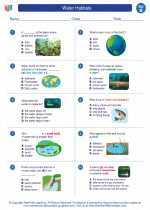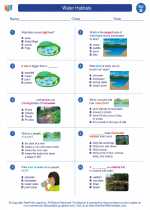Behavior
Behavior refers to the actions and reactions of an organism in response to internal and external stimuli. It can be observed in both humans and animals, and can be influenced by genetics, environment, and learned experiences.
Types of Behavior
There are several types of behavior, including:
- Instinctive Behavior: This type of behavior is innate and is not learned. It is typically present from birth and is often essential for survival, such as a bird building a nest or a baby sucking on a pacifier.
- Learned Behavior: This type of behavior is acquired through experience and is not based on genetics. It can be taught or developed over time, such as a dog learning to sit on command or a child learning to ride a bike.
- Social Behavior: This type of behavior relates to interactions with others within a group or society. It can include cooperation, competition, communication, and other social interactions.
- Abnormal Behavior: This type of behavior deviates from what is considered normal or typical for a given species or individual. It may indicate an underlying problem or disorder.
Factors Influencing Behavior
Several factors can influence behavior, including:
- Genetics: Certain behaviors may have a genetic basis, inherited from parents or ancestors.
- Environment: The surroundings and conditions in which an organism lives can impact its behavior. This includes factors such as food availability, temperature, and social interactions.
- Learning: Through experiences and interactions, organisms can learn and adapt their behavior to different situations.
- Emotions: Feelings and emotions can greatly influence behavior, leading to actions such as aggression, fear, or affection.
Studying Behavior
Scientists study behavior through various methods, including:
- Observation: Watching and recording the actions and reactions of organisms in their natural environment.
- Experiments: Setting up controlled situations to test and observe specific behaviors under different conditions.
- Surveys and Interviews: Gathering information about behaviors through questionnaires, interviews, and other forms of communication.
- Neuroscience: Exploring the biological basis of behavior by studying the nervous system and brain activity.
Understanding behavior is essential for various fields, including psychology, biology, anthropology, and sociology. By studying behavior, researchers can gain insights into the complexities of living organisms and how they interact with their environment and each other.
.◂Science Worksheets and Study Guides Second Grade. Water Habitats
Study Guide Water Habitats
Water Habitats  Activity Lesson
Activity Lesson Water Habitats
Water Habitats  Worksheet/Answer key
Worksheet/Answer key Water Habitats
Water Habitats  Worksheet/Answer key
Worksheet/Answer key Water Habitats
Water Habitats  Worksheet/Answer key
Worksheet/Answer key Water Habitats
Water Habitats  Worksheet/Answer key
Worksheet/Answer key Water Habitats
Water Habitats  Vocabulary/Answer key
Vocabulary/Answer key Water Habitats
Water Habitats  Vocabulary/Answer key
Vocabulary/Answer key Water Habitats
Water Habitats 

 Activity Lesson
Activity Lesson
 Worksheet/Answer key
Worksheet/Answer key
 Worksheet/Answer key
Worksheet/Answer key
 Worksheet/Answer key
Worksheet/Answer key
 Worksheet/Answer key
Worksheet/Answer key
 Vocabulary/Answer key
Vocabulary/Answer key
 Vocabulary/Answer key
Vocabulary/Answer key

The resources above cover the following skills:
LIFE SCIENCE (NGSS)
Biological Evolution: Unity and Diversity
Students who demonstrate understanding can:
Make observations of plants and animals to compare the diversity of life in different habitats[Clarification Statement: Emphasis is on the diversity of living things in each of a variety of different habitats.] [Assessment Boundary: Assessment does not include specific animal and plant names in specific habitats.]